This post may contain affiliate links. Please read our disclosure policy.
If you’re looking for savory breakfast options outside of eggs, I’m with you! Growing up in a Lebanese house, we only ate savory breakfasts like Manakeesh and this Ful Medames (or foul mudammas), which is basically a simple savory stew made with fava beans, chickpeas and spices. It’s easy to make in 20 minutes with only a handful of ingredients!
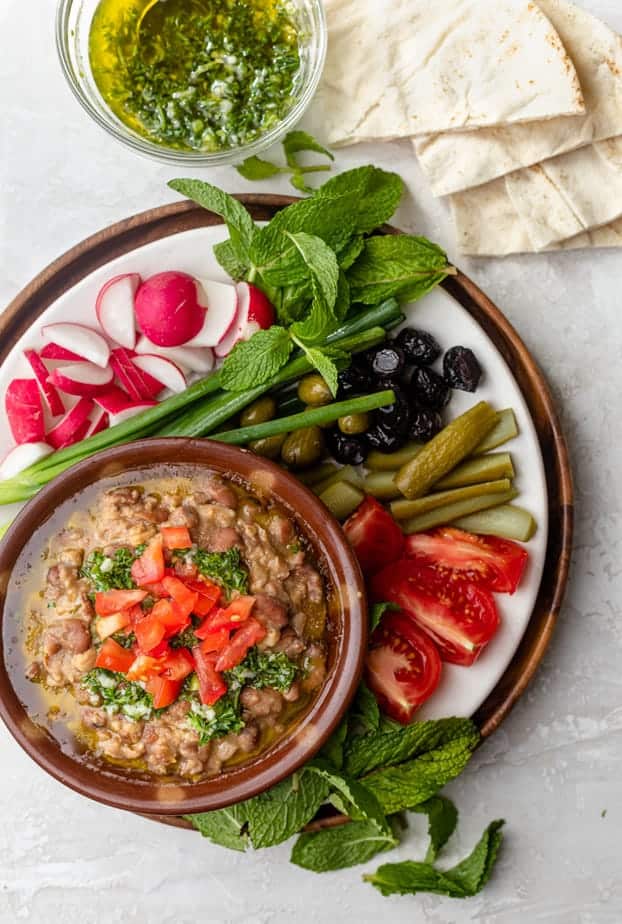
What is ful medames?
Ful medames, or simply fūl, is a stew of cooked fava beans served with olive oil and cumin. It’s also common to serve with chopped parsley, garlic, onions, lemon juice, pepper and other vegetable, herb and spice ingredients. Some people describe ful as a cross between a bean salad and a bean dip. And as such, you can enjoy it on its own with a mix of vegetables or you can use pita to dip, like we do.
Ful is originally from Egypt, but it’s spread through the Middle East, and it’s a very popular Lebanese breakfast now. I’m calling my recipe Lebanese Ful just because of the technique in preparing it, not actually referencing its origin. Like many Middle Eastern recipes, there are so many ways to vary the recipe and the technique. There’s no right or wrong way to make the recipe though.
How do you make ful medamas?
Place the rinsed and drained fava beans and chickpeas along with cumin in a small sauce pan with water. The amount of water you add will come down to preference, but I found that a cup and half is a good measurement for the amount of beans. Bring the mixture to a boil and let simmer until the water is mostly absorbed. Smash the beans with the back of a wooden spoon occasionally.
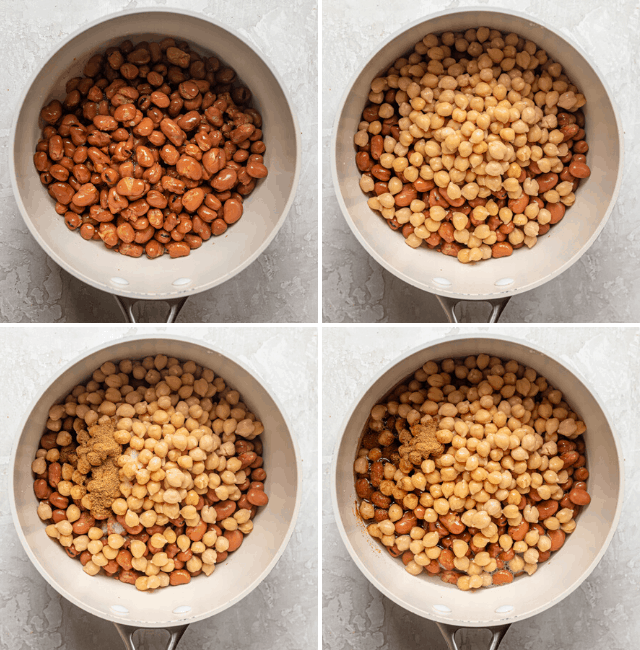
While the ful is cooking, you can prepare the vegetables you’re serving with it. Most importantly, chop some tomatoes and make the sauce to serve it with. The sauce is made with olive oil, lemon parsley, garlic and jalépeno peppers.
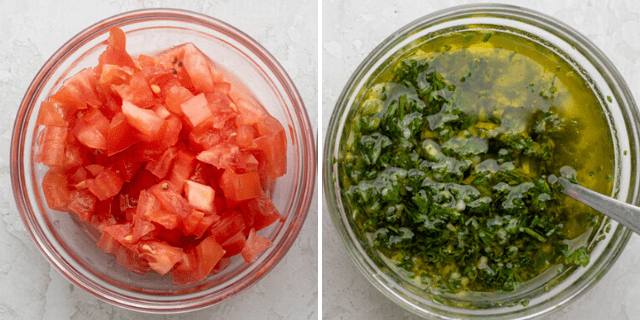
When the ful is done cooking, serve it in a bowl surrounded by any vegetables you like. Some popular ones are tomatoes, radishes, green onions, pickles or cucumbers, olives and fresh herbs like mint. Then you can serve the sauce on top or next to the ful medames along with warm pita.

Tips for making ful medames
- Watch the mixture carefully because cooking times will vary. The cooking time will really depend on the quality and age of the beans, so it will differ from brand to brand. However, if you dry them out too much, you can rehydrate with additional water.
- Make sure to lightly crush the beans while they are simmering. This will help them absorb the liquid as they cook. But more importantly, it helps them absorb the sauce when served, so they become extra flavorful.
- Substitute the fava beans with pinto beans. While it’s traditional to use a mix of fava beans and chickpeas, pinto beans would also work if you cannot find fava beans. They are closest in size and taste.
Frequently asked questions
I’ve been very happy with canned fava beans and canned chickpeas. My parents, husbands’ parents and most of my friends and family opt for canned beans. They make the breakfast recipe quick and easy, and it’s also very easy to enhance them with seasoning and trimmings.
Place the dried fava beans in a pot of water so that they are fully covered and bring them to the boil for three minutes. Then, let the beans soak for an hour until they are fully rehydrated. Be sure to cover the beans with 3 to 4 inches of water above them as they will expand as they rehydrate.
If you have leftovers, or you are making ful medames ahead of time, let it cool to room temperature and place in an airtight container. They will keep in the fridge for about 4 days.They will dry out a little, so stir in some water and/or olive oil into them and reheat on the stovetop or microwave.
I’ve never frozen it myself, but it is freezer friendly! If you decide to freeze the parsley and olive oil mixture, make sure to keep it separately for best results.
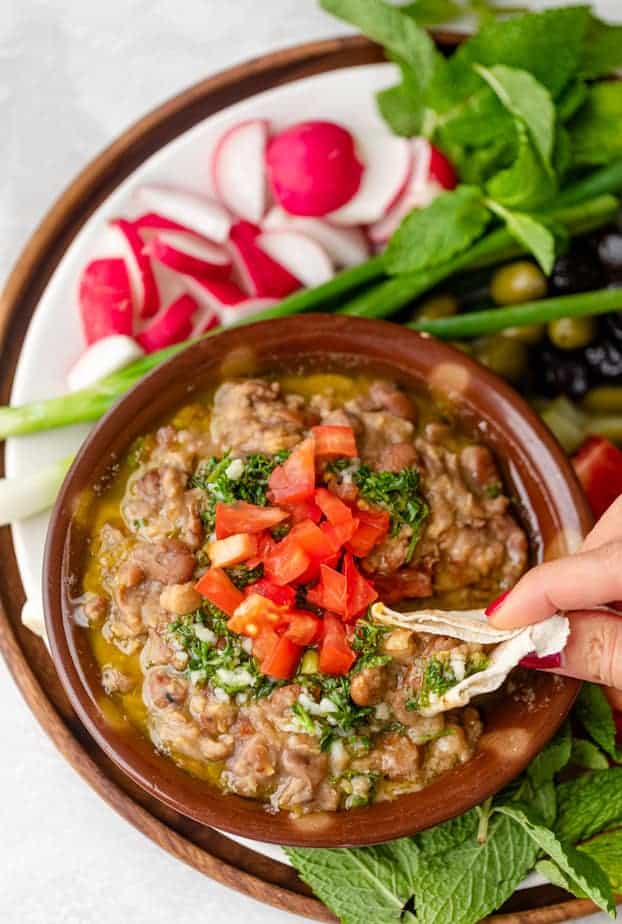
More Lebanese recipes
- Falafel
- Mujadara
- Zaatar Manakeesh
- Homemade Kanafa
- Beef Shawarma
- Chicken Fatteh
- Molokhia
- Ejjeh {Lebanese Omelette}
If you love this recipe, be sure to check out all of my other bean recipes!
Ful medames makes for a hearty and healthy breakfast that is full of flavor. The dish comes together easily and it makes a great breakfast or brunch. We always keep our pantry stocked with a few cans of fava beans and chickpeas, so we can easily make this quick, satisfying breakfast on weekends. I hope you enjoy this as much as we do!
If you’ve tried this feel good Lebanese Ful Medames recipe or any other recipe on FeelGoodFoodie, then don’t forget to rate the recipe and leave me a comment below! I would love to hear about your experience making it. And if you snapped some shots of it, share it with me on Instagram so I can repost on my stories!

Ful Medames
Ingredients
- 2 14 ounces can fava beans
- 1 15 ounces can chickpeas
- 1 teaspoon cumin
- ½ teaspoon Kosher salt
Sauce for topping
- ½ cup extra virgin olive oil
- ¼ cup lemon juice
- ½ cup chopped parsley
- 4 garlic cloves crushed
- 1 tablespoon chopped jalapenos
- Salt and pepper to taste
Instructions
- Pour the fava beans and the chickpeas together into a colander to drain. Rinse the beans in cold water.
- Transfer the rinsed, drained beans to a medium saucepan over medium heat, and add 1 and half cups of cold water. Season with cumin and kosher salt.
- Bring mixture to a boil. Reduce heat to low and let simmer uncovered for 20 minutes until most of the water is absorbed, smashing occasionally with the back of a wooden spoon to get the desired consistency.
- Meanwhile, combine all the ingredients for the sauce in a small bowl.
- When the beans and chickpeas are done cooking, serve the sauce on top or next to the ful medames. You can have stir half the sauce with the bean mixture and serve the other half on the side.
- Serve with fresh parsley on top along with warm pita, tomatoes and radishes.
Notes
Nutrition
Nutrition information provided is an estimate. It will vary based on cooking method and specific ingredients used.
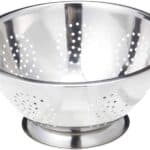

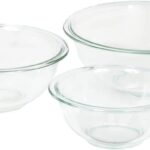
Please add a print button that is not an add for ease of use. Appreciated.
The print button is on the recipe card on the top right-hand side floating on the image. Hope that helps!
Just made this with some slight modifications. I took the oil mixture minus the parsley and heated it in a pan and added some whole cumin seeds. Fried it for 4 minutes. Added that to the finished beans and it was AMAZING!!!
Love that! It sounds amazing!
Just had this for breakfast this morning, and we loved it! Perfect with homemade warm pita, too! Please keep your amazing Lebanese recipes coming!
Thank you so much, Karol! April is a full 30 days of Middle Eastern recipes, so you’ll have lots to look forward to!
Delicious recipe!! However, I’m not sure if I always want that much sodium just in my breakfast meal, do you think that omitting the kosher salt would have a noticeable affect on the final product?? Can’t wait to try it again 🙂
Thank you! You can do that and adjust as needed.
Because you are rinsing the beans before you cook them, the sodium level is greatly reduced.
When using tin Fava broad beans & chickpeas or
Flava beams on its own at what stage do one add cummin
A
You would add cumin to the rinsed and drained fava beans and chickpeas that are cooking on the saucepan. This is in step two of the recipe card.